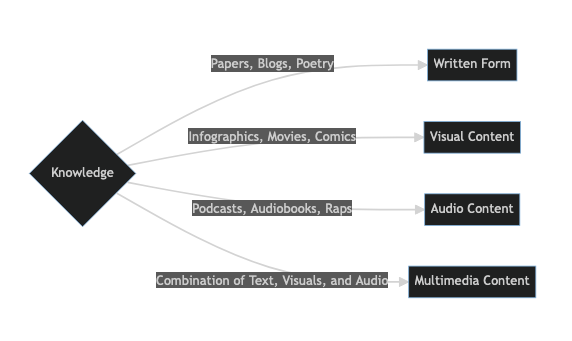Dynamic Knowledge Rendering

In the ever-evolving digital landscape, the nature of content is undergoing an unprecedented transformation. Content, once seen as a one-size-fits-all commodity, has become a multi-dimensional entity, fluid and adaptable, seamlessly transitioning between various forms and formats. It is an exciting age where the boundaries of content are blurring, paving the way for dynamic interactions that defy the norms of conventional media.
At the heart of this transformation is the emergence of knowledge models. Imagine a repository, a neural network of interconnected information that can present the same piece of knowledge in multiple, personalised ways. Knowledge models encapsulate this concept. They are the engine rooms of information, determining how data is stored, connected, and, most importantly, presented to the end user. They are the architects of our modern information era, converting raw data into meaningful, digestible, and personalised content for audiences to consume.

However, it's not enough to just have the knowledge. In this era of information overload, the "how" matters just as much as the "what". Here's where the consumers come into the picture. Each consumer has unique preferences for how they wish to absorb knowledge, driven by factors such as their cognitive style, personal interests, and even the time they have at hand.
This leads to the need for Dynamic Knowledge Rendering.
The importance of employee preferences
Gone are the days when training modules were a one-size-fits-all affair, with little to no regard for individual preferences. Soon, the personalisation of content in the professional setting is not just a perk, it will be an expectation.
Why this emphasis on employee preference, you might wonder? In the digital age, we're all privy to a ceaseless stream of information and learning materials. For employers, the challenge lies in ensuring that these resources resonate with their employees and effectively facilitate their development. By tailoring the content to the employees' preferences, the learning experience becomes more engaging, thereby leading to better comprehension and retention.
But the importance of employee preferences extends beyond just engagement and comprehension. Personalised content can significantly enhance the overall learning experience, making it not just productive but also enjoyable. Some might prefer a deep dive through a meticulously crafted professional paper, while others might find joy in learning through a vibrant comic strip or a catchy rap. By factoring in these preferences, we can create content that speaks to every individual, making the learning process more inclusive and effective.

This shift towards personalised learning has profound implications for organisations and their HR/L&D departments. It's no longer about delivering content in isolation; it's about understanding the employees, their unique learning styles, and their individual needs. It's about crafting learning experiences that cater to these preferences, thereby creating a more engaging and meaningful environment for professional development.
Where to start
Let's consider a multinational company that employs a diverse workforce across the globe. Their annual compliance training is an important affair, but due to language barriers, cultural differences, and varied learning styles, not all employees engage with the content effectively.
Enter Dynamic Knowledge Rendering (DKR). It steps in and transform this generic training module into a variety of formats. For the employees who prefer a visual approach, they present the information as engaging infographics and videos.
For those who learn better with text, detailed articles and interactive quizzes are provided. And for the staff always on the move, podcasts and audiobooks offer an opportunity to learn on the go.
Consider a global customer service team in a multinational technology company, with hundreds of members, who speak 35 different languages among them. Every time a new product is launched, the team needs to familiarise themselves with the ins and outs of the product to effectively assist customers.

The traditional approach might involve a series of lengthy written documents or monotonous webinars, which can be difficult to comprehend, especially when considering language barriers and varied learning preferences.
Here's where Dynamic Knowledge Rendering (DKR) can make a remarkable difference. With it's capability to convert core information into multiple formats and languages, taking into account cultures and geo-nuances, the training material for the new product can be transformed into a multitude of options.
The beauty of this approach lies not only in the variety of formats but also in the personalised learning journey it offers to each team member. DKR ensure that every member, irrespective of their language or learning preference, gets an equal opportunity to understand the product and deliver excellent customer service.
These real-world examples showcase the transformative potential of Dynamic Knowledge Rendering (DKR) in diverse settings, empowering employees and enhancing overall learning experiences. As we advance, it's evident that DKR will play a pivotal role in shaping information delivery, making it more inclusive, engaging, and efficient.
If you and your organisation would like to explore how you could bring employee centric knowledge transfer via DKR to your team please get in touch. email : [email protected]
